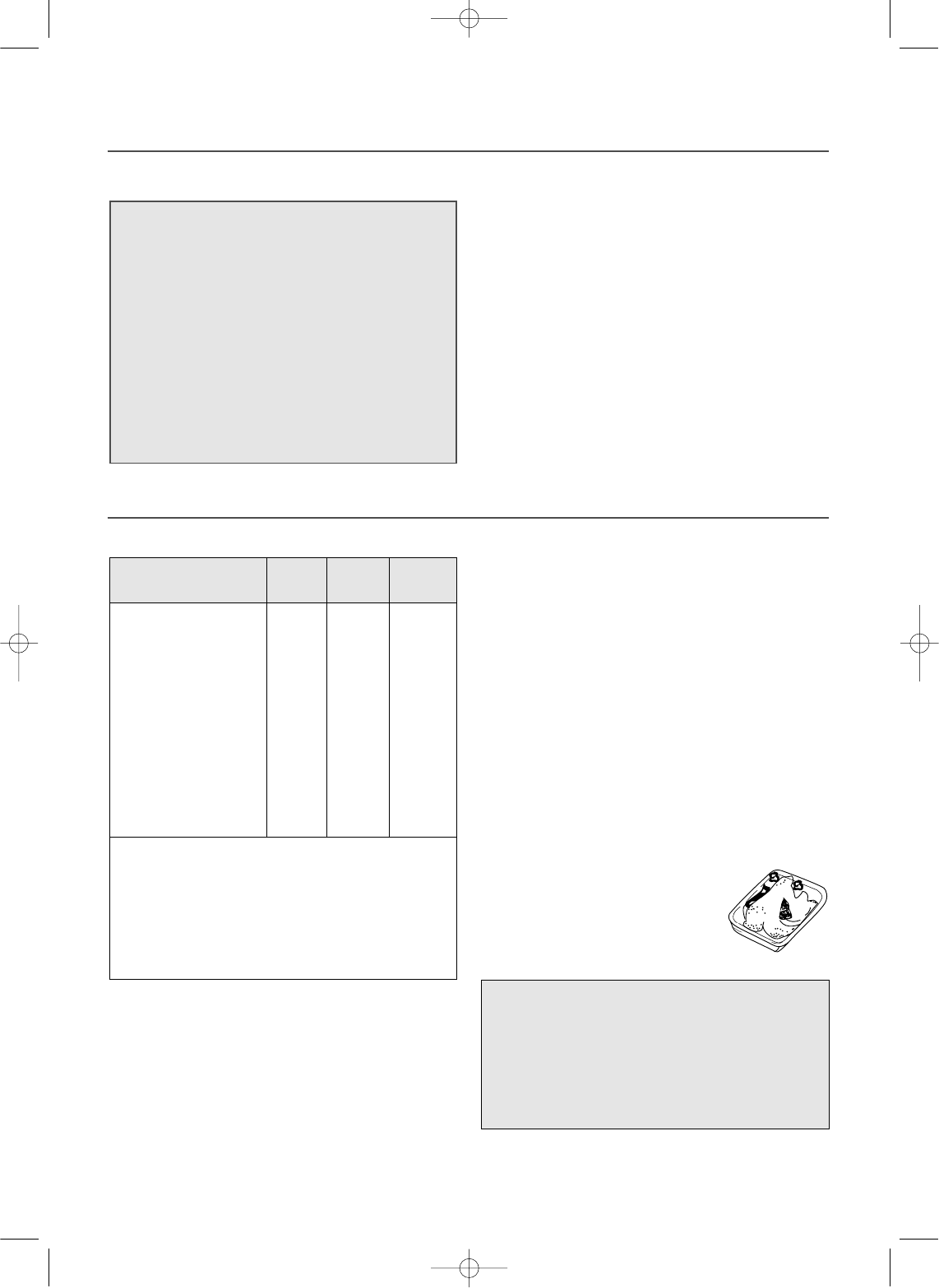
4
Microwave function only
Utensils and cooking containers used in a microwave oven
should be of a material that does not act as a barrier to
microwave energy. Generally this means that you should cook
in either (paper), plastic, glass or ceramic. Metal pans reflect
microwave energy and inhibit cooking, and should not be
used. In addition to material, the shape of the container should
also be considered. Round oval shapes give the most even
cooking. Square or rectangular containers may over-cook
foods in the corners because more energy is absorbed there.
Shallow containers give more even cooking results.
Utensils made of china and ceramic excellent to use in your
microwave oven. Most types of glass are also very good.
Lead crystal glass can crack and should therefore, not be
used. Plastics and paper can also be used, provided they
can withstand the temperature of the heated food. For
cooking only use plastics, which will withstand a temperature
of over 120˚C, e.g. polypropene and polyamide. Some plastic
materials, e.g. melamine, will be heated by the microwave,
and be damaged. To find out if a certain container is suitable,
the following simple test can be made:
Place the empty container and a glass of water inside the
microwave oven. The water is needed because the oven
must not be operated empty or with empty containers only.
Let the oven work on full power for one minute. A suitable
container will only be lukewarm.
Metal containers, e.g. saucepans or frying pans should not
be used in microwave ovens. Nor should plates or vessels
with decorations be used since metal e.g. gold, might be part
of the decoration and such decorations will be damaged.
Small pieces of aluminiuum foil can be
used, but only to shield the areas that
would over-cook (e.g. for covering
chicken wings, leg tips and fish tails) but
the foil must not touch the side of the
oven as damage may occur.
TO AVOID EXPLOSION AND SUDDEN BOILIING
1. Eggs
Never cook eggs in their shells. Steam will build up inside
the shell during cooking and the egg will explode.
If you want to cook or reheat eggs which have not been
broken up by scrambling or mixing, you must always
pierce the yolks or these will also explode. You should
slice shelled hard boiled eggs before you reheat them in
your microwave oven.
2. Piercing
Always pierce food which has a skin or membrane, for
example, potatoes, tomatoes, apples, sausages etc. If you
don't pierce them, steam will build up inside and they may
explode.
3. Lids
Always remove the lids of jars and containers and take
away food containers, before you cook using your
microwave oven. If you don't, then steam and pressure
might build up inside and cause an explosion even after
the microwave cooking has stopped.
WHICH UTENSIL CAN BE USED IN THE OVEN?
WARNING
When heating liquids, e.g. soups, sauces and beverages
in your microwave oven, overheating the liquid beyond
boiling point can occur without evidence of bubbling:
This could result in a sudden boil over of the not liquid.
To prevent this possibility the following steps should be
taken:
a. Avoid using straight sided containers with narrow necks.
b. Do not overheat.
c. Stir the liquid before placing the container in the oven
and again halfway through the heating time.
d. After heating, allow to stand in the oven for a short time,
stir or shake them again carefully and check the
temperature of them before consumption to avoid burns
(especially, contents of feeding bottles and baby food jars).
Glass (general) No Yes (1) No
Glass (heat resistant) Yes Yes Yes
Glass-ceramic and
ceramic (heat resistant) Yes Yes (1) Yes (1)
Earthenware Yes Yes Yes
China (heat resistant) Yes Yes Yes
Plastic (general) No Yes (2) No
Plastic (heat resistant) Yes (2) Yes (2) Yes (2)
Aluminium foil containers
/aluminium foil Yes Yes (3) Yes
Metal baking tins Yes (4) No Yes (4)
Metal (pots.pans, etc) Yes No No
Paper No Yes No
1. Without metal parts or metal trims.
2. Some plastics are heat-proof only to certain temperatures.
Check carefully!
3. It is possible to use aluminium foil to shield deliate areas of
food (this prevents over-cooking).
4. Metal tins can be used in the combination methods, however
if these are very deep, they will greatly reduce the efficiency,
as metal shields the microwave energy from the food.
Caution:
• There are a number of accessories available on the
market. Before you buy, make sure they are suitable
for microwave use.
• When you put food in the microwave oven, make sure
that food, food supports or covering do not come in
direct contact with any of the internal walls or the ceiling
of the cavity since discolouration may take place.
Before use, the user should check that utensils are suitable for use in microwave ovens.
Material
Grill &
Convection
cooking
Microwave
cooking
Combined
cooking
KOC-924T5S(¿ )-Basic 2003.1.2 4:3 PM ˘`4


















